
– Photo by Jan Ketchel
All humans are a composite of masculine and feminine qualities. Typically, though not necessarily, the masculine is highlighted in the conscious personality of men and the feminine in women. Very roughly defined, the masculine refers to the abstract realm of thinking, the feminine to the concrete realm of connection or relatedness.
The contrasexual element in each sex operates at a deeper, less conscious layer of the psyche, in the characters Jung defined as the anima in men and the animus in women. These characters operate quite autonomously within the unconscious psyche and serve as guides and mediators to the deepest layers of the self.
However, when the conscious personality finds itself in a crisis of adaptation in an outer world predicament, the contrasexual inner character springs forth to offer its shield and sword to protect the integrity of the ego, the conscious self.
Often, when a man is confronted by a situation where he feels inadequate or rejected, his anima will quickly tell him he has been treated unfairly and doesn’t deserve such treatment. She may equip him with a mood and suggest that he retreat into solitude and sulkiness where she will attend to his wounds. She will explain to him how he is not properly valued for all that he does and has truly been neglected. She might suggest that he refuse to communicate, as those who disappointed him are unworthy of his attention and should in fact be punished for their insensitivity! She assures him he deserves better and is absolutely justified in his sullen withdrawal.
A woman, similarly challenged with a threat to her worthiness or intelligence, may find herself suddenly possessed by her own inner defender, her animus, in full-fledged armor. As opposed to the anima’s strategy to isolate, shrouded in brooding moodiness, the animus coaches an impassioned emotive attack, armed with words, principles, and vague generalities. The animus wants active battle, the anima passive withdrawal.
The animus will go to battle for the woman, citing principles and arguments to defeat that which seeks to diminish her. Often, the animus refuses rebuff or debate. He fixates on a point and refuses rational argument! Or, if he permits it, will cut down the opponent with a paucity of actual fact.
The defensive activity of both anima and animus rarely results in resolution, but that is never their objective. They come into play to defend and win, to save the ego from needing to face actual inadequacy that could lead to development and change.
If, in humility, the ego could face the truth of its impoverished state, it could begin a process of mining and cultivating its hidden resources lying deep within the unconscious. Developing its actual ability to think and feel would broaden its real understanding and relation to people and the world. However, this is a laborious and slow process of development that requires the nurturing of heretofore underdeveloped abilities. First and foremost, however, the ego must refuse the defensive response of the anima/animus that prevents an honest revelation of the truth of an inadequacy or blameful distortion.
Many of the battles that couples find themselves embroiled in are carried on by the activation of these inner characters, as they take over control of ego interactions between partners. There can never be a solution or a true understanding as long as the modus operandi is winning and saving face at all costs.

– Photo by Jan Ketchel
Only when we are willing to turn to our inner defenders, thank them for their offerings but request that they stay in their own realm, can we begin to discover the truth.
This requires a willingness to withdraw blame, take ownership, and examine the truth of our own inner reactions that may have led to an argument to begin with. Here we will discover the truths that may be hard to face about ourselves. But, armed with this true knowledge, we can begin to make real changes and eventually find our way back to connection on real terms—the basis of true intimacy.
Let the defenders—anima and animus— be relieved of their defensive role and instead take us deeper into our inner soul’s journey where we can discover the full depth of who we are. Let us consciously assume full responsibility for our ego’s maturity, releasing our inner defenders to do their real work as we do ours!
Not defending,
Chuck








